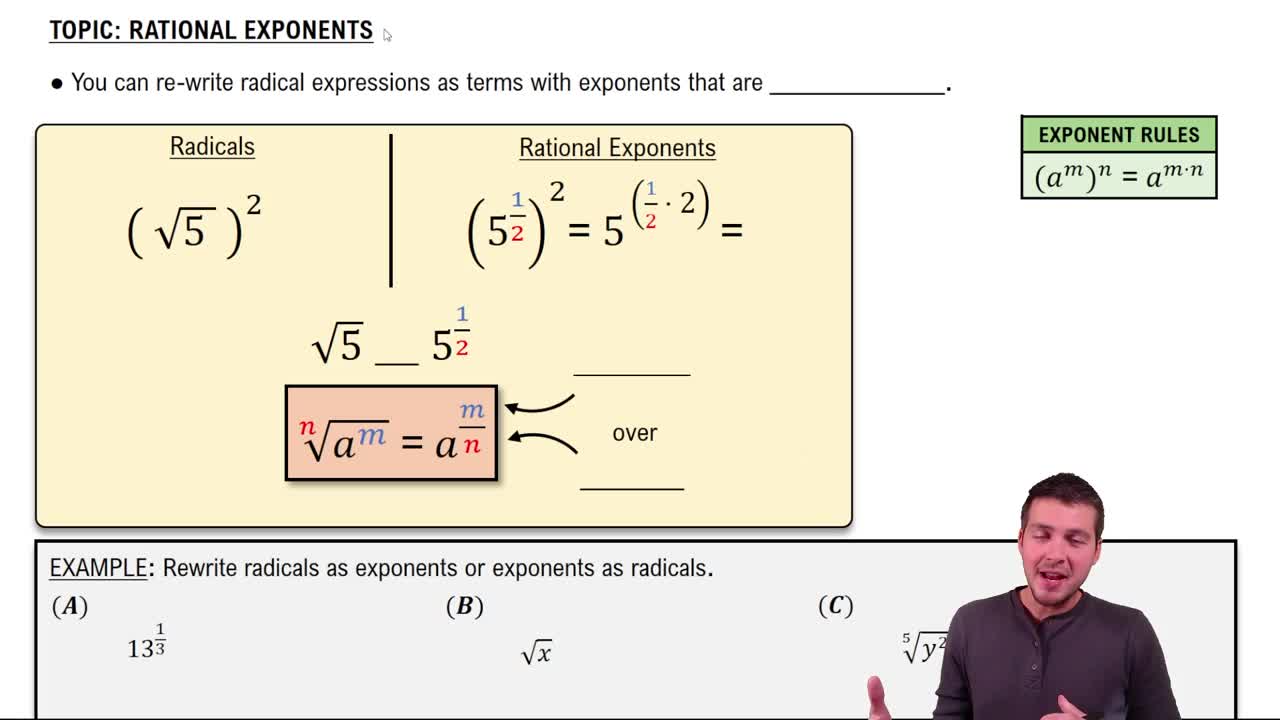Table of contents
- 0. Review of Algebra4h 16m
- 1. Equations & Inequalities3h 18m
- 2. Graphs of Equations43m
- 3. Functions2h 17m
- 4. Polynomial Functions1h 44m
- 5. Rational Functions1h 23m
- 6. Exponential & Logarithmic Functions2h 28m
- 7. Systems of Equations & Matrices4h 6m
- 8. Conic Sections2h 23m
- 9. Sequences, Series, & Induction1h 19m
- 10. Combinatorics & Probability1h 45m
4. Polynomial Functions
Zeros of Polynomial Functions
Problem 14
Textbook Question
In Exercises 9–16, a) List all possible rational zeros. b) Use synthetic division to test the possible rational zeros and find an actual zero. c) Use the quotient from part (b) to find the remaining zeros of the polynomial function. f(x)=2x^3+x^2−3x+1
 Verified step by step guidance
Verified step by step guidance1
Identify the polynomial function: \( f(x) = 2x^3 + x^2 - 3x + 1 \).
List all possible rational zeros using the Rational Root Theorem, which states that any rational zero, \( \frac{p}{q} \), is a factor of the constant term (1) divided by a factor of the leading coefficient (2). Thus, the possible rational zeros are \( \pm 1, \pm \frac{1}{2} \).
Use synthetic division to test each possible rational zero. Start with \( x = 1 \) and perform synthetic division to see if it results in a remainder of 0.
If \( x = 1 \) is a zero, the quotient from synthetic division will be a quadratic polynomial. Use this quotient to find the remaining zeros by factoring or using the quadratic formula.
Continue testing other possible rational zeros if necessary, and use the quotient to find all zeros of the polynomial function.
Recommended similar problem, with video answer:
 Verified Solution
Verified SolutionThis video solution was recommended by our tutors as helpful for the problem above
Video duration:
5mPlay a video:
Was this helpful?
Key Concepts
Here are the essential concepts you must grasp in order to answer the question correctly.
Rational Root Theorem
The Rational Root Theorem provides a method for identifying all possible rational zeros of a polynomial function. It states that any rational solution, expressed as a fraction p/q, must have p as a factor of the constant term and q as a factor of the leading coefficient. For the polynomial f(x)=2x^3+x^2−3x+1, this theorem helps in listing potential rational zeros to test.
Recommended video:
Guided course

Rational Exponents
Synthetic Division
Synthetic division is a simplified form of polynomial long division used to divide a polynomial by a linear factor of the form (x - c). It allows for efficient computation of the quotient and remainder, making it easier to test potential rational zeros. If the remainder is zero, then (x - c) is a factor of the polynomial, confirming c as a zero of the function.
Recommended video:

Higher Powers of i
Finding Remaining Zeros
Once an actual zero is found using synthetic division, the polynomial can be expressed as a product of the linear factor corresponding to that zero and a reduced polynomial. The remaining zeros can then be found by factoring or using the quadratic formula on the reduced polynomial. This process is essential for fully solving the polynomial equation and identifying all its roots.
Recommended video:

Finding Zeros & Their Multiplicity
Related Videos
Related Practice



